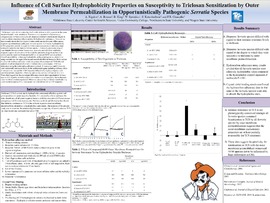| dc.contributor.author | Rigsbee, A. | |
| dc.contributor.author | Benton, A. | |
| dc.contributor.author | King, B. | |
| dc.contributor.author | Sprinkles, W. | |
| dc.contributor.author | Katz-Amburn, S. | |
| dc.contributor.author | Champlin, F. R. | |
| dc.date.accessioned | 2020-04-14T16:12:36Z | |
| dc.date.available | 2020-04-14T16:12:36Z | |
| dc.date.issued | 2019-02-22 | |
| dc.identifier | ouhd_rigsbee_influenceof_2019 | |
| dc.identifier.citation | Rigsbee, A., Benton, A., King, B., Sprinkles, W., Katz-Amburn, S., & Champlin, F. R. (2019, Feb. 22). Influence of cell surface hydrophobicity properties on susceptivity to triclosan sensitization by outer membrane permeabilization in opportunistically pathogenic Serratia species. Poster presented on Research Day at the Oklahoma State University Center for Health Sciences, Tulsa, OK. | |
| dc.identifier.uri | https://hdl.handle.net/11244/323863 | |
| dc.description.abstract | Unlike most hydrophobic molecules, the biocide triclosan is able to penetrate the gram-negative bacterial outer membrane. The nosocomial opportunists Pseudomonas aeruginosa and Serratia marcesens are typically resistant to triclosan due largely to outer membrane impermeability properties for hydrophobic substances. However, we have recently shown that the degree of outer membrane involvement differs among disparate opportunistically pathogenic Serratia species. Cell surface hydrophobicity (CSH) properties underlie susceptivity to triclosan sensitization by outer membrane permeabilization in opportunistic Serratia species. A model system consisting of opportunistic Serratia species (marcesens, fonticola, and odorifera) exhibiting disparate degrees of susceptivity to hydrophobic antibacterial agents and triclosan sensitization by outer membrane permeabilizer compound 48/80 were examined. Overall susceptability to disparate hydrophobic antibacterial agents was determined using conventional disc agar diffusion and macrobroth dilution bioassays. Batch culture kinetics with triclosan and outer membrane permeabilizer compound 48/80 allowed analysis of cell envelope involvement in intrinsic triclosan resistance. CSH was determined using the hydrocarbon adherence method. S. marcesens and S. fonticola intrinsically resistant to hydrophobic antibacterial agents including triclosan, while S. odorifera was susceptible. CSH properties differed only slightly compared with control organisms, regardless of how susceptive they were to triclosan sensitization. These data suggest that the phenotypic differences seen in three opportunistic Serratia species with regard to intrinsic resistance to triclosan are at least partly due to disparate outer membrane exclusion potential. Moreover, susceptivity to triclosan sensitization by outer membrane permeabilization appears not to be influenced by CSH properties. | |
| dc.format | application/pdf | |
| dc.language | en_US | |
| dc.publisher | Oklahoma State University Center for Health Sciences | |
| dc.rights | The author(s) retain the copyright or have the right to deposit the item giving the Oklahoma State University Library a limited, non-exclusive right to share this material in its institutional repository. Contact Digital Resources and Discovery Services at lib-dls@okstate.edu or 405-744-9161 for the permission policy on the use, reproduction or distribution of this material. | |
| dc.title | Influence of cell surface hydrophobicity properties on susceptivity to triclosan sensitization by outer membrane permeabilization in opportunistically pathogenic Serratia species | |
| osu.filename | ouhd_rigsbee_influenceof_2019.pdf | |
| dc.type.genre | Presentation | |
| dc.type.material | Text | |
